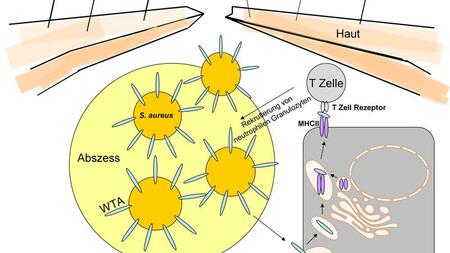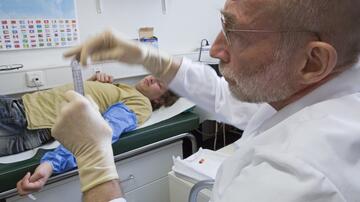Scientists decipher a mechanism in serious skin infections
The cell envelope sugar polymer wall teichoic acid (WTA) of Staphylococcus aureus plays a role in the development of skin infections. A strong immune reaction accelerates the formation of an abscess
Scientists from the University of Tübingen and the German Center of Infection Research (DZIF) have been able to demonstrate that sugar polymers on the outer cell envelope of Staphylococcus aureus mean that the disease progresses in a particularly aggressive way – and this suggests a starting point for possible treatment. The results were published in the Nature Microbiology specialist journal.
Staphylococcus aureus is one of the most feared, multi-resistant pathogens. The bacterium often causes life-threatening infections, particularly in people with a weakened immune system. During the last few years, especially aggressive strains of S. aureus have appeared around the globe, known as so-called “Community-Associated Methicillin-Resistant Staphylococcus aureus” or CA-MRSA, and they can even trigger serious infections in the skin and tissue of healthy people. Scientists from the Interfaculty Institute of Microbiology and Infection Medicine, Tübingen (IMIT) and the German Center for Infection Research (DZIF) have been able to decipher an important mechanism in the occurrence of this infection.
The group of scientists has been able to demonstrate that CA-MRSA strains can change their outer cell envelope by inserting increasing amounts of a long-chain sugar polymer, the cell wall teichoic acid. “It’s well-known that CA-MRSA strongly increases the secretion of toxins, which plays a major role in the serious progression of skin infections,” said Dr. Christopher Weidenmaier, the head of the research group. “We’ve now also been able to prove that the increased insertion of the sugar polymer into the cell envelope creates a change in the immune reaction in the case of skin infections. This,” he added, “increased the ability of these aggressive bacteria to cause particularly serious skin infections in animal experiments. However, additional research is required to determine if the results also hold true in humans.
The authors were in a position to decipher the molecular mechanisms more precisely, which underlie the modification in the cell envelope. This will open up the possibility of deliberately preventing the modification process in serious skin infections caused by CA-MRSA strains in the future. “This kind of therapeutic approach would give the human immune system the chance to combat the infection more efficiently itself,” Weidenmaier said. These so-called anti-virulence strategies have been increasingly explored in recent times; in this case, the pathogen itself is not attacked, but its pathogenic effect. “In contrast to classic antibiotic treatment, an anti-virulence strategy should lead to lower resistance rates,” the scientist explained. “Because the bacterial cell is not killed off or inhibited in its growth, it is subject to less evolutionary pressure.”




